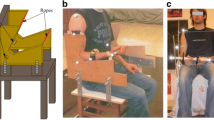Summary
A method of determining quantitatively the rotary flexibility of the elbow joint was developed and its reliability tested. Examinations of the left elbow joint of 100 healthy men between the ages of 18 and 72 were performed, consisting of measurements of passive supination effected by a graduated external torque as well as of active supination and pronation. The purpose of the study was to acquire a norm as basis for the functional evaluation of this joint in playing the violin. The investigation produced the following results:
-
1.
The maximum active range of movement consists of about 160‡, the supinatory portion is generally higher than the pronatory, when related to a zero position with the palm of the hand in the sagittal plane.
-
2.
The range of passive movement is non-linearly dependant on the external torque.
-
3.
The variability of passive flexibility increases with decreasing external torque and is generally higher than the variability of active flexibility. Active pronation varies more than active supination.
-
4.
A close positive correlation between active and passive supination is evident only when a higher torque is applied. The correlation between active supination and active pronation is only 0.33.
-
5.
The statistically establishable reduction of flexibility through ageing is not considered to be characteristic of actual conditions. On the other hand, a broader dispersion is clearly recognizeable as the result of ageing, through a drop in the lower limit of deviation.
Similar content being viewed by others
Literatur
Allander, E., Björnsson, O. J., ólafsson, ó., SigfÚsson, N., Thorsteinsson, J.: Normal range of joint movements in shoulder, hip, wrist and thumb with special reference to side: a comparison between two populations. Int. J. Epid. 3, 253–261 (1974)
American Academy of Surgeons: Joint Motion. Method of Measuring and Recording (6th reprint). Edinburgh-London: Churchill Livingstone 1966
Barter, J. T. et al.: A statistical evaluation of joint range data. Cit. Hertzberg, H. T. E.: Engineering anthropology. In: Human engineering guide to equipment design (H. P. van Cott, R. G. Kinkade, eds.). Washington: US Government Printing Office 1972
Benninghoff, A., Goerttler, K.: Lehrbuch der Anatomie des Menschen, 1. Bd., 11. Aufl. (J. Staubesand, Hrsg.) München-Berlin-Wien: Urban & Schwarzenberg 1975
Bugyi, B.: Beitrag zur AltersabhÄngigkeit des metakarpo-phalangealen Gelenkes des 5. Fingers. Z. Alternsforsch. 18, 24–25 (1965)
Bunnel, S.: Die Chirurgie der Hand (deutsche übersetzung von J. Böhler). Wien-Bonn-Bern: Maudrich 1958
Ellis, F. E., Bundick, W. R.: Cutaneous elasticity and hyperplasticity. A.M.A. Arch. Derm. 74, 22–32 (1956)
Emmrich, R., Schwarz, J.: Die Gelenkbeweglichkeit in AbhÄngigkeit vom Altern und ihr Verhalten bei verschiedenen Krankheiten. Z. Alternsforsch. 16, 297–303 (1963)
Fick, R.: Handbuch der Anatomie und Mechanik der Gelenke, Teil III. Jena: Fischer 1911
Goddard, R., Dowson, D., Longfield, M. D., Wright, V.: The measurement of stiffness in human joints. Rheologica Acta 8, 229–234 (1969)
Goddard, R., Dowson, D., Longfield, M. D., Wright, V.: Steifheit des Knies bei Gesunden und bei Arthrosepatienten. Schweiz. med. Wschr. 100, 862–867 (1970)
Hultkrantz, J. W.: Das Ellenbogengelenk und seine Mechanik. Jena: Fischer 1897
v. Lanz, T., Wachsmuth, W.: Praktische Anatomie. I/3 Arm, 2. Aufl. Berlin-Göttingen-Heidelberg: Springer 1959
Loebl, W. Y.: Mobility of metacarpophalangeal joints in rheumatoid arthritis. The Hand 2, 165–169 (1973)
McCue, B. F.: Flexibility measurements of college women. Res. Quart. Amer. Ass. Hlth phys. Educ. 24, 316–324 (1953)
Sachs, L.: Statistische Auswertungsmethoden, 2. Aufl. Berlin-Heidelberg-New York: Springer 1969
Schink, W.: Handchirurgischer Ratgeber. Berlin-Göttingen-Heidelberg: Springer 1960
Schoberth, Hanns: Die Leistungsprüfung der Bewegungsorgane. München-Berlin-Wien: Urban & Schwarzenberg 1972
Siegelbauer, F.: Lehrbuch der normalen Anatomie des Menschen, 3. Aufl. Berlin: Urban & Schwarzenberg 1935
Wagner, Ch.: Determination of finger flexibility. Europ. J. appl. Physiol. 32, 259–278 (1974a)
Wagner, Ch.: Biomechanische Funktionsprüfungen der Hand. In: Neue Gesichtspunkte zu den Folgen der chronischen Polyarthritis — ihre Feststellung und Behandlung. Symposion Timmendorfer Strand 1973. Konstanz: Byk Gulden Pharmazeutika 1974b
Wagner, Ch.: Physiologische Voraussetzungen für das Geigenspiel. In: Violinspiel und Violinmusik in Geschichte und Gegenwart (V. Schwartz, Hrsg.). Wien: Universal Edition 1975
Wright, V., Johns, R. J.: Quantitative and qualitative analysis of joint stiffness in normal subjects and in patients with connective tissue diseases. Ann. rheum. Dis. 20, 36–45 (1961)
Author information
Authors and Affiliations
Additional information
Supported by the Stiftung Volkswagenwerk, Hannover
Rights and permissions
About this article
Cite this article
Wagner, C. Determination of the rotary flexibility of the elbow joint. Europ. J. Appl. Physiol. 37, 47–59 (1977). https://doi.org/10.1007/BF00421598
Received:
Issue Date:
DOI: https://doi.org/10.1007/BF00421598




